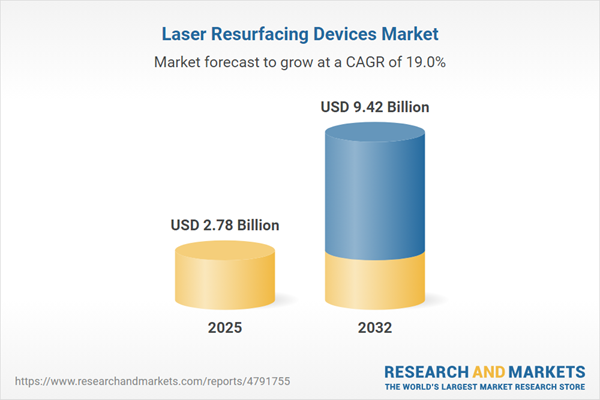Speak directly to the analyst to clarify any post sales queries you may have.
The laser resurfacing devices market is undergoing dynamic transformation, shaped by advancing technologies and evolving patient expectations. Senior healthcare executives must anticipate shifts and align organizational strategies to maintain their position in this innovation-driven sector.
Market Snapshot: Laser Resurfacing Devices Market Size and Growth
The global laser resurfacing devices market is valued at USD 2.34 billion with projections indicating a rise to USD 2.78 billion by 2025 and a further increase to nearly USD 9.42 billion by 2032. Achieving a CAGR of 19.01%, the sector’s upward trend is propelled by growing demand for minimally invasive skin procedures, consistent advancements in energy-based technologies, and broad application across both aesthetic and medical domains. Expanding patient engagement and the continual evolution of device capabilities are prompting organizations to fine-tune market strategies. Senior decision-makers with a solid grasp of consumer shifts and technology innovation are positioned for sustainable advantage as the market landscape evolves.
Scope & Segmentation of the Laser Resurfacing Devices Market
- Product Types: Ablative systems, such as CO₂ and Er:YAG lasers, target precise resurfacing for defined clinical or cosmetic outcomes. Non-ablative devices, like Nd:YAG and pulsed dye lasers, enable less invasive treatments for a wide array of patients.
- Modalities: Stationary platforms serve high-volume healthcare settings, while portable solutions extend treatment capabilities to a range of environments, supporting greater care access and flexibility.
- Treatment Areas: Devices cover the face, neck, chest, and body, allowing healthcare professionals to personalize interventions in line with specific patient objectives.
- Applications: The technology supports pigment correction, scar reduction, wrinkle minimization, and overall skin rejuvenation, contributing to a more diversified clinical offering.
- End Users: Dermatology clinics, specialty hospitals, and medical spas rely on device adaptability to serve the needs of broad and varied patient bases.
- Sales Channels: Procurement occurs through direct sales, authorized distributors, and online platforms, enabling seamless device adoption in diverse practice settings.
- Region Coverage: The market spans the Americas, Europe, Middle East & Africa, and Asia-Pacific. Each territory exhibits unique regulatory requirements, demographic characteristics, and technology adoption patterns.
- Competitive Landscape: Companies including Lumenis Ltd., Alma Lasers Ltd., Candela Corporation, Cutera, Hologic, Lutronic Corporation, Sciton, Fotona d.o.o., Syneron Medical Ltd., and Solta Medical are actively shaping advancements to optimize outcomes for practitioners and patients.
Key Takeaways for Senior Decision-Makers
- Expanding the available portfolio of laser systems enables organizations to deliver tailored, results-oriented solutions, improving patient satisfaction and quality of care.
- Adoption of hybrid and fractional technologies supports treatment flexibility, enhances resource utilization, and meets specialized therapeutic requirements across broader population groups.
- Integrating portable device solutions strengthens organizational ability to reach emerging or underserved regions where access to healthcare infrastructure may be limited.
- The application of artificial intelligence in procedural standardization leads to greater operational efficiency and consistent outcomes across multiple clinic sites.
- Establishing alliances with leading technology providers ensures readiness for regulatory or technical transitions and accelerates device integration.
- Continuous monitoring of regional compliance standards provides senior teams with the insight to refine strategies, mitigate risk, and support smooth expansion initiatives.
Tariff Impact: 2025 United States Tariffs and Strategic Response
Forthcoming tariff changes in the United States are prompting manufacturers to reassess sourcing and logistics approaches. Healthcare organizations can address potential supply uncertainties by strengthening supplier networks and refining procurement methods. Effective supplier management is integral to continuity of patient services during regulatory adjustments.
Methodology & Data Sources
This assessment synthesizes insights from more than thirty industry experts, incorporates current regulatory information, and evaluates trusted industry publications. The analytical approach draws on multiple authoritative data sources, equipping executives to make strategic choices on technology investment and scaling within the laser resurfacing devices market.
Why This Report Matters
- Delivers practical guidance that informs capital allocation and operational planning for organizations adapting to rapid laser technology evolution.
- Clarifies the complexity of regulatory and compliance demands, enabling companies to design resilient operational structures both regionally and globally.
- Supports effective vendor assessment and integration, laying the foundation for ongoing growth amid shifting market dynamics.
Conclusion
Sustained success in the laser resurfacing devices market will rely on continuous technology integration, adaptable service delivery, and proactive responses to sector trends and regulatory developments.
Additional Product Information:
- Purchase of this report includes 1 year online access with quarterly updates.
- This report can be updated on request. Please contact our Customer Experience team using the Ask a Question widget on our website.
Table of Contents
3. Executive Summary
4. Market Overview
7. Cumulative Impact of Artificial Intelligence 2025
Companies Mentioned
The companies profiled in this Laser Resurfacing Devices market report include:- Lumenis Ltd.
- Alma Lasers Ltd.
- Candela Corporation
- Cutera, Inc.
- Hologic, Inc.
- Lutronic Corporation
- Sciton, Inc.
- Fotona d.o.o.
- Syneron Medical Ltd.
- Solta Medical, Inc.
Table Information
| Report Attribute | Details |
|---|---|
| No. of Pages | 192 |
| Published | October 2025 |
| Forecast Period | 2025 - 2032 |
| Estimated Market Value ( USD | $ 2.78 Billion |
| Forecasted Market Value ( USD | $ 9.42 Billion |
| Compound Annual Growth Rate | 19.0% |
| Regions Covered | Global |
| No. of Companies Mentioned | 11 |









